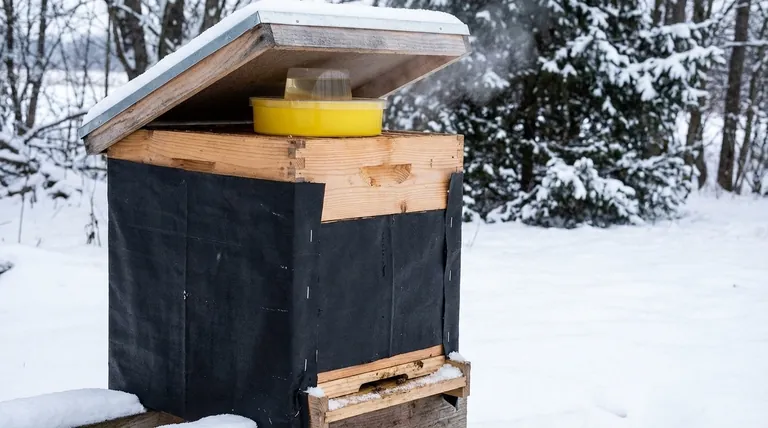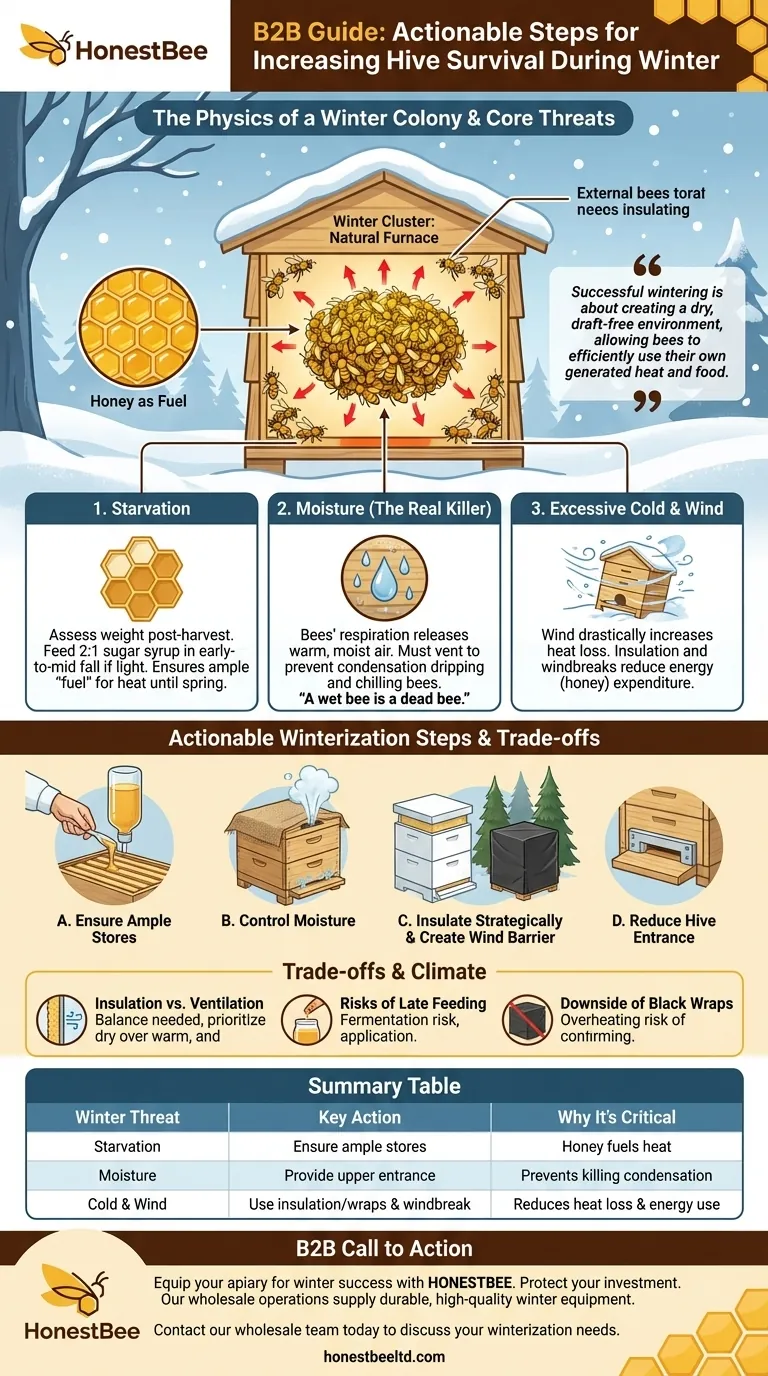To increase hive survival during winter, you must manage the three core threats: starvation, moisture, and excessive cold exposure. Success involves ensuring the colony has ample food stores, providing adequate ventilation to remove moisture, and using insulation or wraps to protect the hive from harsh winds and heat loss.
Successful wintering is not about heating the hive from the outside. It is about creating a dry, draft-free environment that allows the bees to efficiently use their own generated heat and food reserves to survive the cold months.

The Physics of a Winter Colony
Before taking action, it's critical to understand what happens inside a hive during winter. Your goal is to support the bees' natural survival strategy, not work against it.
The Winter Cluster: A Natural Furnace
As temperatures drop, honeybees form a tight ball known as the winter cluster.
Bees on the inside of this cluster generate heat by flexing their flight muscles. The bees on the outside act as a living layer of insulation, rotating inward as they cool.
Honey as Fuel
The energy required to generate this heat comes directly from their food stores—honey.
A colony's winter survival is a race against time. They must have enough honey to fuel their "furnace" until spring flowers bloom again.
The Real Killer: Moisture
While bees generate heat, their respiration also releases a significant amount of warm, moist air.
When this water vapor hits a cold inner surface of the hive, it condenses into water droplets. If this cold water drips back down onto the cluster, it will chill and kill the bees far more effectively than the outside air temperature. A wet bee is a dead bee.
Actionable Winterization Steps
With these principles in mind, you can take specific, effective steps to prepare your hives for the challenges of winter.
Ensure Ample Food Stores
This is the most critical factor. After the final honey harvest, assess the hive's weight.
If it feels light, you must feed them a 2:1 sugar-to-water syrup in the fall. This allows them to store enough "fuel" to last until spring.
Control Destructive Moisture
Proper ventilation is essential to allow moist air to escape.
An upper entrance is a common and effective method. It provides an exit point for warm, moist air and a way for bees to leave for cleansing flights on warmer days. Adding absorbent materials like burlap under the outer cover can also help capture condensation.
Insulate Strategically
Insulation reduces the amount of energy (honey) the bees must expend to keep the cluster warm.
Options range from modern polystyrene hives, which offer superior insulation, to wrapping traditional wooden hives. A simple insulated inner cover on top of the hive is highly effective, as this is where most heat is lost.
Create a Wind Barrier
Wind drastically increases heat loss from the hive, forcing the bees to consume more honey.
Positioning hives behind a natural windbreak like a line of trees is ideal. If that isn't possible, create a barrier using straw bales or a simple fence. Wrapping the hive in black tar paper or a commercial hive wrap also serves this purpose.
Reduce the Hive Entrance
A large entrance is an open door for drafts and predators.
Use an entrance reducer to shrink the opening to its smallest size. This helps maintain internal temperature and makes it easier for the colony to defend against mice or robbing bees.
Understanding the Trade-offs
Effective wintering requires balancing competing needs. Misunderstanding these trade-offs can do more harm than good.
Insulation vs. Ventilation
This is the central dilemma of winterization. Heavy insulation is effective, but without adequate ventilation, it will trap destructive moisture inside the hive.
Always prioritize a dry hive over a warm one. Ensure any insulation or wrap you apply still allows for air exchange, typically through an upper entrance.
Risks of Late Season Feeding
Feeding sugar syrup must be done in early-to-mid fall.
If you feed too late in the season, the bees may not have time to dehydrate the syrup and cap it properly. This high-moisture "honey" can ferment, and its consumption can cause dysentery in the colony.
The Downside of Black Wraps
While black wraps help absorb solar radiation on sunny days, they can also cause problems.
On a bright winter day, the wrap can heat the hive enough to make the bees think it's spring, encouraging them to break cluster and fly out into fatally cold air. This is less of a risk in very cold climates but a real concern in areas with sunny but cold winters.
Making the Right Choice for Your Climate
Your winterization strategy should be adapted to your specific environmental conditions.
- If your primary focus is surviving a very cold, snowy climate: Prioritize top insulation to prevent heat loss and ensure the hive entrance remains clear of snow, which itself can act as a good insulator.
- If your primary focus is navigating a damp, milder winter: Prioritize moisture control and ventilation above all else; a well-ventilated hive is more important than a heavily insulated one.
- If you are a new beekeeper and unsure where to start: Focus on the two most critical factors: ensuring the hive has more than enough food and providing a simple windbreak.
By managing for a dry, draft-free hive with a full pantry, you give your bees the best possible chance to emerge strong and healthy in the spring.
Summary Table:
| Winter Threat | Key Action | Why It's Critical |
|---|---|---|
| Starvation | Ensure ample honey/sugar stores | Honey fuels the bees' heat-generating winter cluster. |
| Moisture | Provide upper entrance for ventilation | Prevents condensation from dripping on and killing bees. |
| Cold & Wind | Use insulation/wraps and a windbreak | Reduces heat loss, conserving the colony's energy. |
Equip your apiary for winter success with HONESTBEE.
As a commercial beekeeper or distributor, protecting your investment through the winter is paramount. Our wholesale-focused operations supply the durable, high-quality equipment mentioned in this guide—from insulated hive components to essential feeding supplies—helping you build resilient colonies that survive and thrive.
Let's prepare your hives together. Contact our wholesale team today to discuss your winterization needs.
Visual Guide

Related Products
- HONESTBEE Round Hive Top Bee Feeder for Syrup
- Rapid Bee Feeder White Plastic 2L Round Top Feeder for 8 or 10-Frame Bee Hives
- HONESTBEE Entrance Bee Feeder Professional Hive Nutrition Solution for Beekeeping
- Classic Boardman Entrance Bee Feeder Hive Front Feeding Solution
- Professional Hive Top Bee Feeder for Beekeeping
People Also Ask
- What types of hive boxes is the round hive top feeder compatible with? Universal Fit for 8 & 10-Frame Langstroth Hives
- What is the correct method for preparing sugar syrup for bees? Ensure Safe, Non-Toxic Feeding for Your Hives
- How do you set up and use a top feeder for bees? A Step-by-Step Guide for Safe Feeding
- What can the round hive top feeder be used for? A Guide to Efficient, Safe Bee Feeding
- What features make top feeders a reliable choice for beekeepers? A Guide to Safe, Efficient Hive Nutrition



















